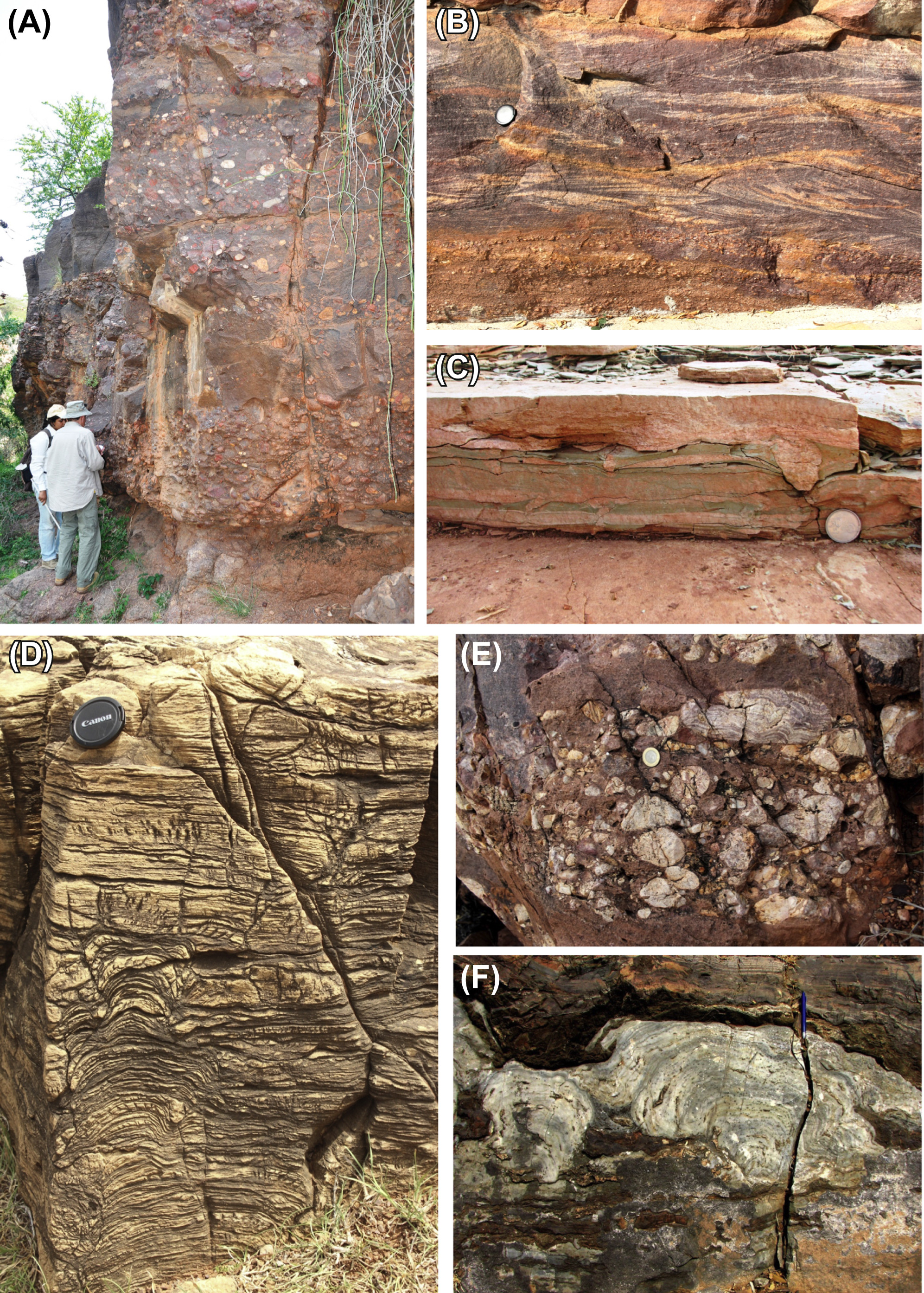Gulcheru Quartzite Fm
Type Locality and Naming
Lower formation of Papghani Gr
Lithology and Thickness
Conglomerate, feldspathic sandstone and quartzite. Dominated by psammites with a thin basal interval of conglomerate. The basal part of the Gulcheru Quartzite consists of matrix to clast supported, thick-bedded polymictic conglomerate with occasional interbeds of gritty feldspathic sandstone (Fig. image A), together making up about 15 m of the Chinna Tandrapadu section. Pebble size clasts in the basal part include subangular to subrounded pebbles of vein quartz, granite, pegmatite, micaceous sandstone, black chert, jasper, and gray shale, likely derived from the adjoining basement with patches of greenstone. The gritty to coarse sandy matrix consists of subangular to subrounded grains of quartz and pink feldspar, locally with ferruginous patches.
This basal conglomeratic unit grades to massive to trough cross-stratified Gritty-pebbly feldspathic sandstone, which, in turn, is overlain by medium-to-coarse grained, well sorted, rippled to cross-stratified glauconitic sandstone (Fig. image B). The topmost part consists of heterolithic dark brown micaceous shale-fine sandstone (Fig. image C) with bipolar trough cross-strata, mud cracks, halite casts, and occasional lag pebbles. Reports of trace fossils and organic-mat-induced sedimentary structures from the Gulcheru Quartzite also exist.
[Figures: Field photographs showing lithology and sedimentary features in the Papaghni Gr of the Cuddapah Supergroup. Gulcheru Quartzite Fm - (A) basal conglomerate overlying granitic basement off Parnapalli; and (B) pebbly grit grading to rough cross-stratified coarse sandstone. (C) Heterolithic sandstone-shale at Gulcheru Quartzite Fm / Vempalle Fm transition. (D) Vempalle Fm - stromatolitic limestone, (E) Pulivendla Quartzite Fm - basal conglomerate; note silicified stromatolite remnant in a large pebble. Tadpatri Fm - (F) silicified stromatolite (hemispheroidal forms) intercalated with basaltic flow (dark band). (from Saha et al., 2016)]
Relationships and Distribution
Lower contact
Unconformity on Peninsular Gneiss, Dharwar Batholith and greenstone belt (Archean). Lies directly over the weathered granite gneisses of the Dharwar batholith in the Guvvalcheruvu section (type area in Cuddapah district) and other sections like Parnapalle (Anantpur district) or Chinna Tandrapadu (Kurnool district), along the western margin of the basin. Figure image A (above).
Upper contact
Overlain by Vempalle Fm limestone with a gradual contact.
Regional extent
Relatively older part of the sedimentary succession is restricted to the Papaghni subbasin and constitutes the bulk of the Cuddapah Supergroup
GeoJSON
Fossils
Age
Depositional setting
Alluvial fan in the basal part; tidal flat in the upper part. The existence of trough cross-strata in the gritty interbeds, channel lags, outsized clasts, and lateral thinning out of the stack of conglomerate beds together with a general-fining upward facies has been interpreted to represent alluvial-fan setting for the basal part. Paleocurrent data from measurement of trough cross-stratification in the lower to middle part shows that the dominant paleoflow was toward N through east-north-east to eastsouth- east, as one follows the arcuate western margin of the basin from south to north. A tectonically controlled alluvial fan system with multiple cycles of basement uplift and erosion during the basin opening stage is suggested by the facies association within the Gulcheru Quartzite. Peneplanation of the source region is indicated by the gradual passage of debris flow to sheet flood (basal unit) and fluvial facies (middle part), ultimately giving way to the development of intertidal flats in the upper part.
Additional Information
